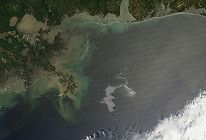Google reveals its forest protection plans in COP16
Preservation of the world’s forests is considered a central element in the struggle to cope with climate change, and Google has unveiled new technology to aid progress.

 Preservation of the world's forests is considered a central element in the struggle to cope with climate change, and Google has unveiled new technology to aid progress.
Preservation of the world's forests is considered a central element in the struggle to cope with climate change, and Google has unveiled new technology to aid progress.
According to a recent report from the UN, "Assessing the Environmental Impacts of Production and Consumption: Priority Products and Materials from the United Nations Environment Programme (UNEP)", deforestation and forest degradation are responsible for approximately 17 per cent of global greenhouse gas emissions.
Yesterday (2nd December) morning in Cancun, Mexico, at the 16th Conference of Parties (COP16), Google unveiled its newest product, Google Earth Engine, which combines an open application programming interface (API) and 25 years of satellite imagery. Google states it will donate 20 million central processing unit (CPU) hours of Google Earth Engine to groups in the developing world.
REDD+ is widely considered to be a central, low cost option for reducing carbon emissions while providing other significant benefits to forest dependent communities. Measuring, reporting and verification (MRV) and monitoring for REDD+ are seen as pivotal processes towards the success of the scheme, underlined the UN-REDD Programme publication, "Perspectives on REDD+", launched yesterday.
New tools offered by Google are anticipated to improve the implementation of monitoring efforts, generating information that helps policies and goals to be reached.
While the software and satellite imagery in Google Earth are already being used in the analysis and reporting of climate change, Google Earth Engine provides parallel processing computing power so that groups can use satellite imagery to analyse the environmental conditions of an area, helping suitable sustainable decisions to be made.
In an interview with Reuters, Rebecca Moore, Engineering Manager for Google Earth Engine, said that the project is derived from the shift of Google.org to a model of "tech-driven philanthropy."
Google has worked with the government of Mexico to create an innovative, high-resolution map of Mexico's forests, which NGOs and the Mexican government will be able to use in decision making regarding land use, sustainable agriculture and protection of biodiversity.
The new parallel computing platform has allowed the time it takes to collect and analyse data to be condensed so that the urgent issues of climate change can be dealt with in a more timely way.
The Department of Energy also made a donation of computer power for battling climate change this week, awarding time on two of the world's super computers to 57 research projects that could develop energy technology.
The UN-REDD publication states: "Land use change is an area where for example, full cover and frequent remote sensing data might be useful as the basis for operational monitoring." Google Earth Engine, as well as other technological advancements and sharing, is anticipated to further these processes so that the most sustainable decisions for the environment and for forest dependent peoples can be made.
Author: Marianna Keen | Climate Action
Image: uscgd8/ Flickr






